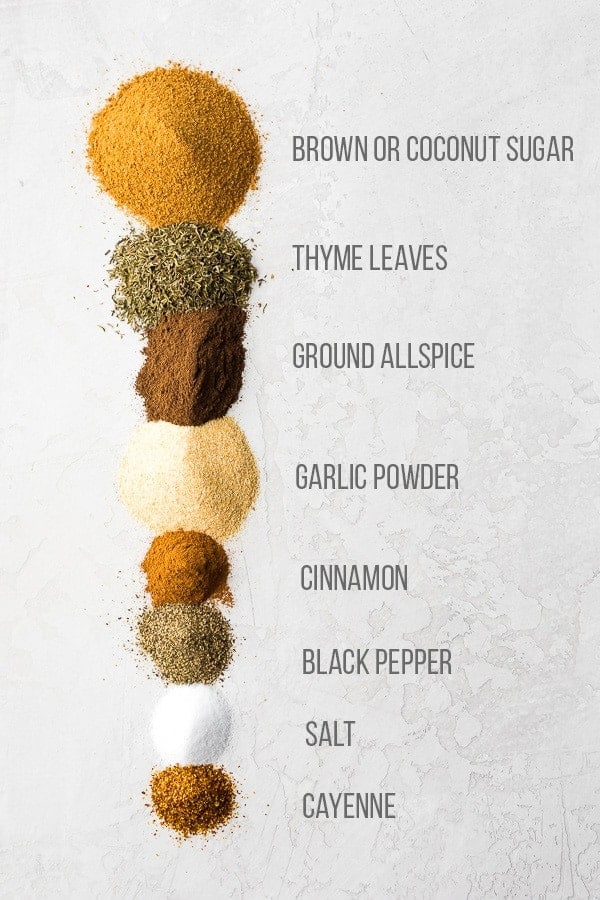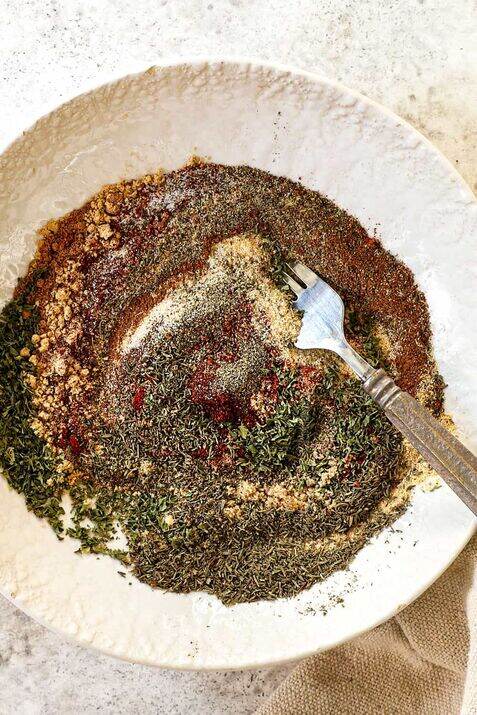Imagine biting into a dish that bursts with flavor, where every mouthful takes you on a trip to the sunny Caribbean. That’s the magic of a good jerk seasoning rub. It’s not just a spice mix; it’s a passport to a world of taste sensations.
In this post, we’ll share a jerk seasoning rub recipe that’s so simple, that anyone can make it. You’ll learn which spices to use, how to mix them just right, and tips for cooking dishes your family will love. Get ready to transform your kitchen into the best island eatery around!

Quick and Simple Ingredients
Creating your own jerk seasoning rub starts with gathering the right spices. You’ll need:
- 4 tablespoons of ground allspice
- 2 tablespoons of dried thyme
- 2 tablespoons of brown sugar
- 1 tablespoon of ground black pepper
- 1 tablespoon of paprika
- 1 tablespoon of cayenne pepper (or less if you want it milder)
- 2 teaspoons of garlic powder
- 2 teaspoons of onion powder
- 1 teaspoon of cinnamon
- 1 teaspoon of nutmeg
- 1 teaspoon of salt (optional)

These ingredients are the secret to that authentic Caribbean flavour. Allspice and thyme are the stars, with a supporting cast of sweet, spicy, and warm notes from the other spices.
Making Your Jerk Seasoning in 5 Steps
Let’s turn these spices into the best jerk rub you’ve ever tasted.
- Gathering Your Spices: First, make sure your spices are fresh for the best flavour. Check the dates on the bottles, and if they smell weak when you open them, it’s time for new ones.
- Combining the Ingredients: Pour all your spices into a big bowl. Use a spoon to mix them up until everything looks even. It’s like making a mini spice rainbow!
- The Right Way to Grind Your Spices: If you have whole spices, you’ll need to grind them. You can use a coffee grinder or a mortar and pestle. Be careful not to turn them into dust. A little bit chunky is just right.
- Storing for Freshness: Scoop your new jerk seasoning into an airtight jar. Keep it in a cool, dark place like a cupboard. This way, it stays fresh and tasty for your next cookout.
- Safety First: Spices like cayenne pepper can make you sneeze or cough if they get in the air. So, when you’re mixing, do it gently. And remember to wash your hands after, especially before touching your eyes.

Cooking with Jerk Seasoning
Jerk seasoning isn’t just for chicken. It’s a versatile spice mix that can add a Caribbean kick to many dishes. Here’s how to use it:
- Jerk Chicken: A Classic Dish: Rub the seasoning onto chicken pieces, making sure they’re well coated. Let them marinate for at least an hour, or overnight for the best flavour. Grill or bake until the chicken is cooked through and has a nice, crispy skin.
- Vegetarian Options: Jerk Veggies: Sprinkle the seasoning over vegetables like bell peppers, onions, and zucchini. Toss them with a little oil and roast or grill for a spicy side dish. You can also mix the seasoning into rice or beans for a flavorful vegan meal.
- Jerk Seafood: A Spicy Twist: Seafood like shrimp and fish fillets taste great with a jerk rub. Coat them lightly with the seasoning, then grill or pan-fry. The spices will create a delicious crust and add a burst of flavour.

Customizing Your Jerk Seasoning:
One of the best things about making your own seasoning is that you can adjust it to your taste. Here are some ideas:
- Adjusting Spice Levels to Your Taste: If you love heat, add more cayenne pepper. If you prefer it milder, use less. You can also add other spicy ingredients like chopped fresh chilli peppers or a dash of hot sauce.
- Alternative Ingredients for Dietary Needs: If you can’t have sugar, use a sugar substitute or leave it out. For a salt-free version, skip the salt and use other herbs and spices to add flavour. You can also try different types of sugar or salt to change the taste.

Tips for the Perfect Jerk Seasoning Balance
Getting the balance right in your jerk seasoning is key to creating dishes that are full of flavour without being overwhelming. Here’s how to achieve that perfect harmony:
- Taste as You Go: When mixing your spices, taste the blend before you add it to your food. It should be spicy, sweet, and aromatic. If it’s too hot, add more brown sugar to balance it out. If it’s too mild, a pinch more cayenne pepper can turn up the heat.
- Layering Flavors: Jerk seasoning is all about layers of flavour. Start with the allspice and thyme as your base. Then build up the sweet notes with brown sugar and warm spices like cinnamon and nutmeg. Finally, add the heat with cayenne pepper and black pepper.
- Pairing with Foods: Jerk seasoning goes well with more than just meat. Try it on grilled pineapple for a sweet and spicy treat. It’s also great on roasted sweet potatoes or stirred into a creamy pasta sauce for a Caribbean twist on your favourite dishes.

Making Jerk Seasoning a Kitchen Staple
Once you’ve mastered making your own jerk seasoning, you’ll find it’s a versatile spice mix that you can use in many ways. Here are some ideas to make it a staple in your kitchen:
- Create a Jerk Marinade: Mix your jerk seasoning with some oil and a splash of soy sauce or lime juice to create a marinade. It’s perfect for soaking chicken, pork, or even tofu before cooking.
- Jerk Seasoning as a Dry Rub: Use the seasoning as a dry rub for meats before grilling or roasting. It creates a delicious crust that locks in the juices and flavours.
- Spice Up Your Snacks: Sprinkle some jerk seasoning on popcorn or nuts for a quick snack with a kick. It’s an easy way to add some excitement to your munchies.

With these additional sections, your blog post will guide readers through the nuances of making and using jerk seasoning, ensuring they get the most out of this flavorful spice mix. Enjoy your culinary journey!
Final Analysis
As we wrap up our journey into the world of jerk seasoning, remember that cooking is an art and spices are your palette. With your new homemade jerk seasoning, you have the power to transform simple ingredients into culinary masterpieces that are bursting with flavor.
Whether you’re grilling up a storm with jerk chicken, adding a Caribbean flair to your vegetables, or experimenting with seafood, the key is to have fun and enjoy the process. Don’t be afraid to tweak the recipe to suit your taste buds or dietary needs. After all, the best recipes are the ones that you make your own.
We hope this guide has inspired you to explore the vibrant tastes of jerk seasoning and to get creative in your kitchen. So go ahead, give it a try, and watch as your dishes come alive with the spirited flavors of the Caribbean. Happy cooking!
Disclosure: Our blog contains affiliate links to products. We may receive a commission for purchases made through these links. However, this does not impact our reviews and comparisons. We try our best to keep things fair and balanced, in order to help you make the best choice for you.








One Comment